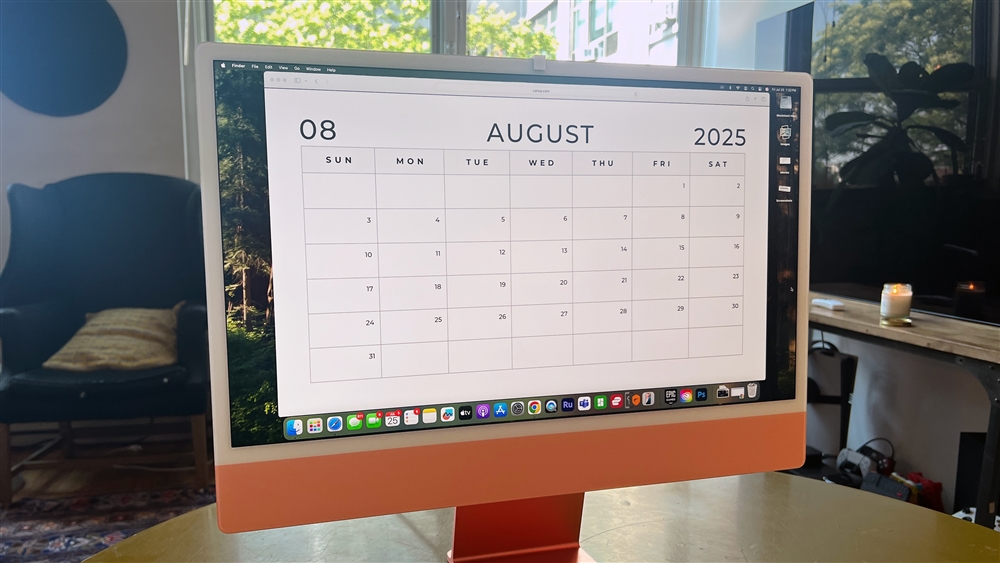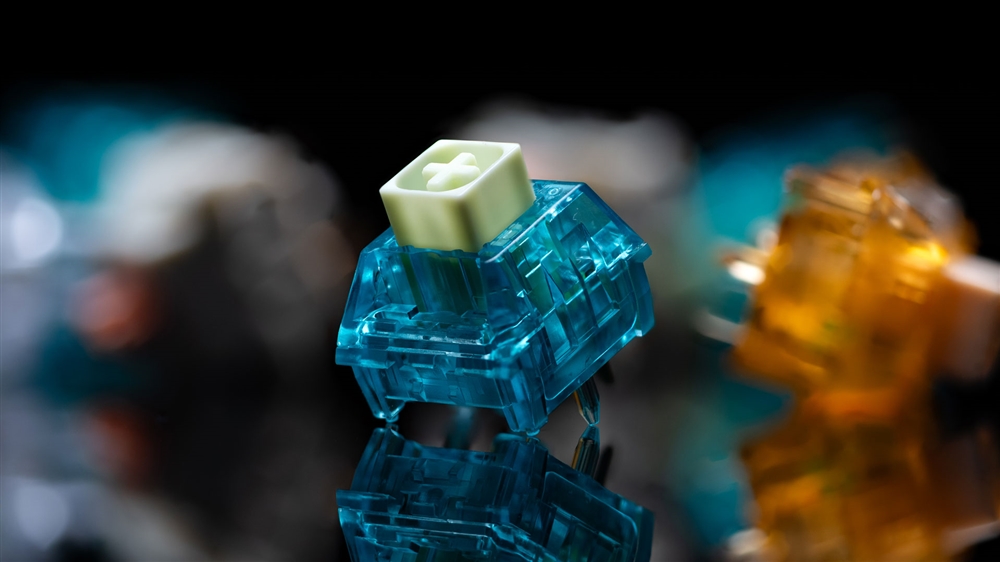How to Choose a Camera: The Ultimate Camera Buying Guide
Looking to buy a new camera but unsure where to start? This guide breaks down the essentials of choosing the perfect camera, whether you're considering a DSLR or a mirrorless model. Learn about the key differences between popular camera types and explore crucial factors like sensor size, megapixels, autofocus, and video features.How-To
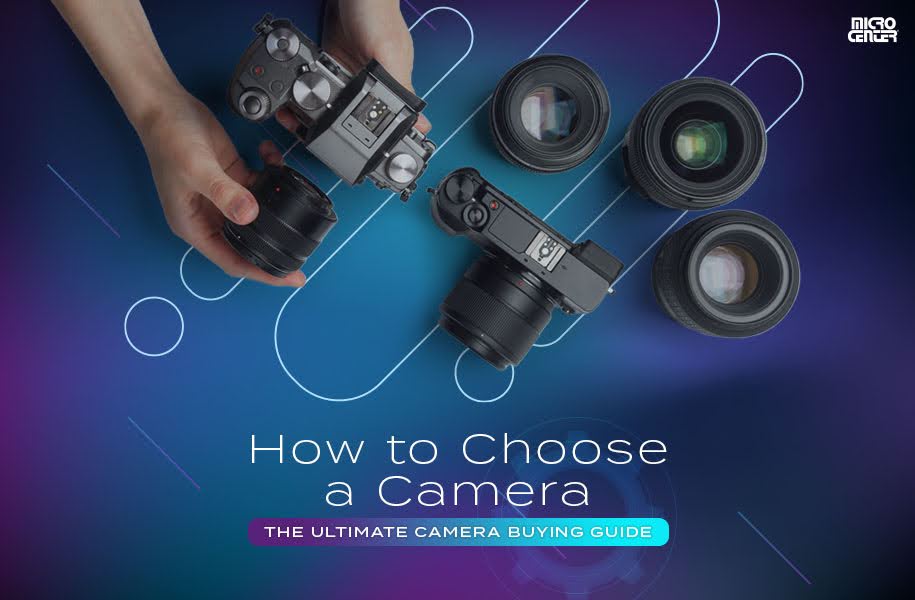
A great camera can unlock all kinds of personal and career opportunities. From shooting and filming your own content to learning professional photography skills, getting behind the lens can be an incredibly rewarding part of your life.
Understanding Camera Types
One of the first big choices in selecting a new camera is deciding whether you want a DSLR or mirrorless camera. Let's run a quick comparison of the basic differences between the two.
DSLR Cameras: Pros and Cons
Digital single-lens reflex (DSLR) cameras are the traditional entry point for photographers moving beyond phone cameras or point-and-shoot models. A mirror and prism inside the camera reflect the light entering the lens so your image is visible in the camera's viewfinder. The mirror then switches position to allow the photo sensor to capture the image when you press the shutter.
- Pro: DSLRs use an optical viewfinder, which provides a true real-time view of what you're shooting with no lag.
- Pro: DSLRs are a mature technology with a wide selection of lenses and accessories available, often at highly competitive prices.
- Pro: When using the optical viewfinder, DSLR cameras offer a long-lasting battery life that most mirrorless cameras still can't quite match.
- Con: Due to the mirror inside, DSLRs are generally heavier and bulkier than mirrorless cameras.
- Con: Most DSLRs can shoot high-quality video, but they may not offer the continuous, adjustable autofocus that makes mirrorless cameras good for videography.
- Con: For high-speed applications like sports photography, DSLRs can't shoot quite as quickly as a mirrorless camera.
- Con: Although they're far from obsolete, DSLRs are gradually being phased out by camera manufacturers. DSLRs will still be available for many years, but mirrorless cameras will get most of the coolest new accessories and technological improvements.
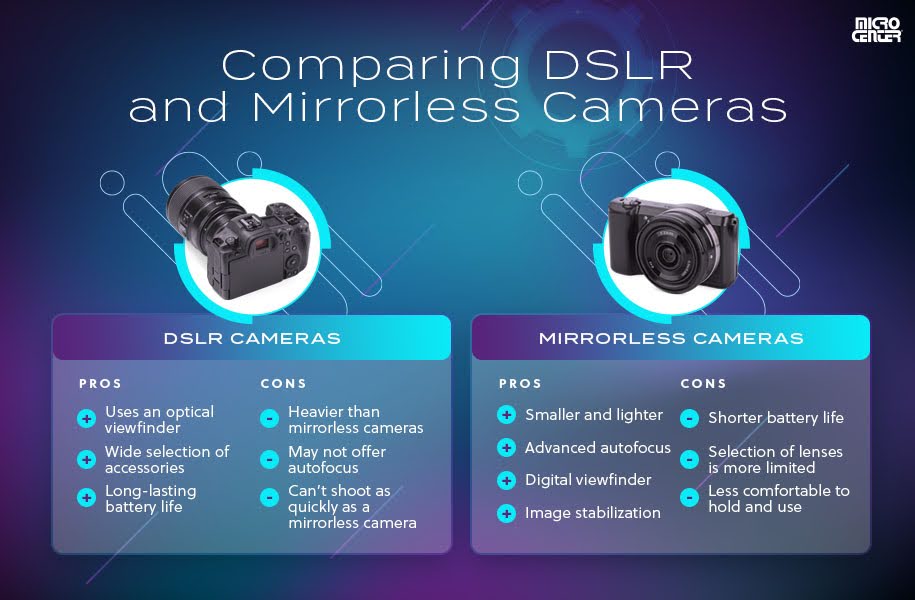
Check Out Our Selection of DSLR Cameras
Mirrorless Cameras: Pros and Cons
Mirrorless cameras are exactly what they sound like: cameras that eliminate the DSLR's mirror mechanism and expose the image sensor directly to light from the lens. This technological advancement provides several major benefits that make mirrorless cameras a strong choice for both novice and expert photographers.
- Pro: The lack of a mirror and prism makes mirrorless cameras substantially smaller and lighter than DSLRs, so they're highly portable and may fit more easily in camera bags.
- Pro: Nearly all mirrorless cameras can also shoot video, and their advanced autofocus capabilities are ideal for videography of all kinds.
- Pro: The fast shooting speed of a mirrorless camera is perfect for burst photography applications, like shooting a sports event.
- Pro: The digital LCD viewfinder of a mirrorless camera conveniently shows aspects like exposure and white balance adjustments, which you won't see in an optical viewfinder.
- Pro: Image stabilization features in mirrorless cameras are often more advanced thanks to their lighter design and lack of moving parts.
- Pro: Mirrorless cameras are the future of photography and will continue to receive new improvements and accessories.
- Con: Due to their LCD screens, mirrorless cameras generally have a shorter battery life than DSLRs, which means you might need to carry an extra battery or two on a long shoot.
- Con: Since mirrorless cameras are newer than DSLRs, their selection of lenses is more limited. However, many DSLR lenses are compatible with mirrorless cameras if you use an adapter, and new lenses for mirrorless cameras arrive every day.
- Con: Some photographers find the smaller bodies and controls of mirrorless cameras less comfortable to hold and use.
Factors to Consider When Choosing a Camera
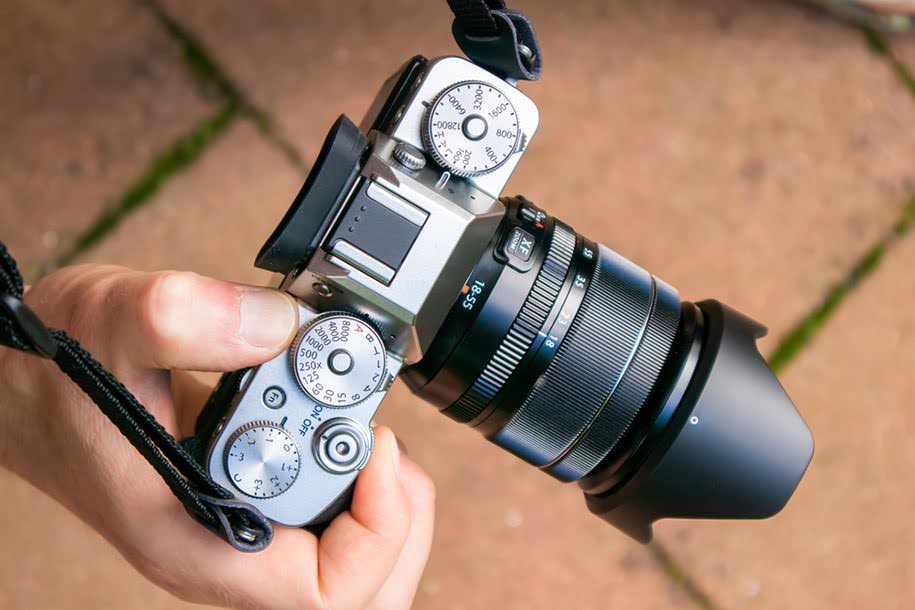
Use Cases
First and foremost, what do you want from your camera? Start by thinking about what, when, and how you'll be shooting — then look for the features that match your use case:
- Portraits: Eye detection autofocus, wide aperture compatibility, large sensor size
- Nature/Wildlife: Fast autofocus, high burst rate, weather sealing, good battery life, long telephoto lens support
- Events: Low-light performance, face and eye autofocus, multiple memory card slots, light and compact
- Sports: High burst rate, tracking autofocus, weather sealing, long telephoto lens support
- Landscape/Architecture: High-resolution sensor, wide-angle lens support, weather sealing
- Videography: 4K filming resolution, long recording length, continuous autofocus, high-quality microphone or room for peripherals
- Livestreaming/Vlogging: Clean HDMI output, direct USB streaming, tracking autofocus
Sensor Size and Resolution
The sensor is where your camera captures the image — in other words, it's where the magic happens. The size and resolution of your sensor have a huge impact on the quality of your photos, so it's important to know the basics of how they work.
First, look at the size of your sensor, measured in millimeters (mm). This controls the size, field of view, and depth of field that you can capture in an image, as well as the quality of the image itself. The three most common sensor sizes are:
- A full-frame camera sensor is the largest format at 36mm x 24mm. Full-frame is a popular choice for serious photographers who want the best possible quality.
- An APS-C sensor, the popular middle ground, is 25.1mm x 16.7mm. APS-C is a great all-purpose sensor size for beginners that shoots well in a variety of contexts.
- Micro 4/3, the smallest common sensor size, is 17.3mm x 13mm. Micro 4/3 cameras are compact, affordable, and offer an excellent depth of field.
Second, look at the resolution of the sensor, measured in megapixels (MP). Entry-level and intermediate models typically have a sensor between 20 and 30 MP, which is plenty for capturing ultra-HD shots. If you're planning to shoot video with your new camera, pay attention to the maximum video resolution and frame rate, which we'll discuss more in a second.
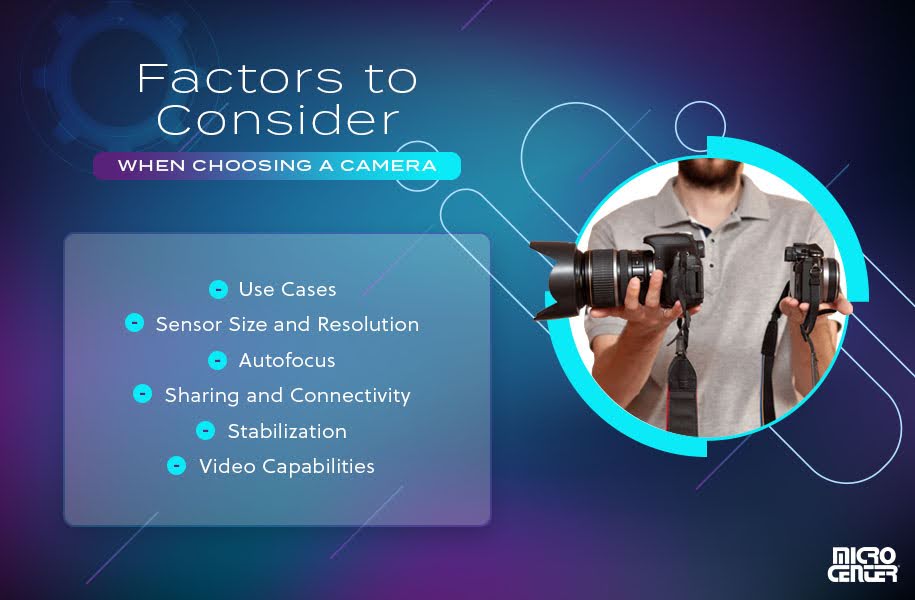
Autofocus
Any modern camera will include a sophisticated autofocus that makes it easy to pick out your subject without constantly twisting your lens to refocus. If you've heard about technical debates such as the comparison of phase detection vs. contrast detection autofocus, don’t worry about it too much — most cameras today use a hybrid focus system anyway, which provides the best of both worlds.
However, certain beginner-friendly autofocus features can make a difference. Face and eye detection and AF-A focus (which automatically switches between single-target and continuous focus) are both great for new shooters. Tracking autofocus, meanwhile, keeps a consistent focus on a moving target, while touchscreen autofocus provides a tap-to-focus interface that will be familiar to anyone who’s used their phone for photography.
Sharing and Connectivity
It's the 21st century, and most of us expect to be able to share, edit, AirDrop, and otherwise do what we need with our photos, wherever we are. Some of the important connectivity features you might want to look for include:
- Wi-Fi and Bluetooth: While most cameras include Wi-Fi and Bluetooth connectivity, the quality of the connection and the usability of the connectivity interface can vary. Reading reviews can give you a better idea.
- Remote Connectivity: Many cameras now also allow you to connect your smartphone and use it as a remote control for shutter operation, focus adjustment, and other key functions.
- Social/Cloud Connection: Want to upload your images straight to social media or your cloud storage drive? Cameras increasingly offer these features — although, again, the functionality of the interface may be better on some models than others.
- Near-Field Communication (NFC): Some cameras now offer near-field communication, which allows instant image transfer to nearby paired devices.
- Direct USB Streaming: Livestreamers should look for a camera with the ability to connect directly to a computer via USB-C. This allows the camera to serve as a high-quality, feature-rich webcam at the center of your streaming setup.
Stabilization
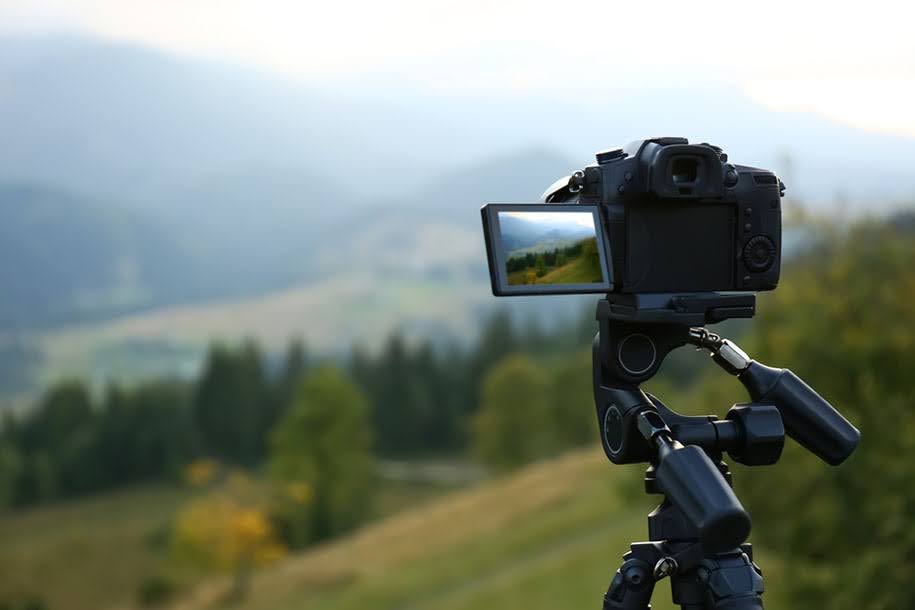
In-body image stabilization (IBIS) is the gold standard for reducing shakes in photos and videos, but it's considered a premium feature. Optical image stabilization (OIS) is built into the lens and is also a strong choice, particularly for telephoto video shots. Digital stabilization crops the frame to reduce shaking and is considered the most affordable but least preferable option.
Most professional photographers and videographers lean on a combination of IBIS and OIS in their shoots. Digital stabilization has improved in quality and is perfectly workable for beginning photographers — but if you're planning to shoot video, you'll want to go for a camera that at least offers OIS.
Video Capabilities
Today's cameras include HD video capabilities that can appeal to everyone from event videographers to streamers to amateur filmmakers. Keep these aspects in mind when you're evaluating a camera’s video capabilities:
- Resolution/Frame Rate: Most cameras can now shoot in any resolution up to and including 4K UHD. However, remember to check the frame rate, too, as not every camera may be able to shoot at your preferred fps rating.
- Audio: High-quality audio is important for video recording, so every camera built for video should have an internal microphone. Check the specs and reviews of the camera's mic, and take note of whether it offers inputs for external audio equipment like XLR cables or headphones.
- Clean HDMI Output: This feature allows the camera to display its output on an external screen, such as the ones that many streamers and cinematographers use, or send it directly to a streaming platform. The key factor is to ensure that the HDMI output is "clean," meaning it's free of built-in overlays and allows you to see only the image.
- Recording Time: Many cameras designed principally for photo use have a built-in time limit on video recording. Videographers will want to check the camera’s recording limits if they plan to use it for extended shots.
Choosing a Lens: The Basics
Entry-level cameras typically come with a starter lens, which is almost always a kit lens (see below). Enthusiast camera models are often sold "frame-only," meaning you'll need to purchase your lens separately or choose to add it on to your new camera purchase.
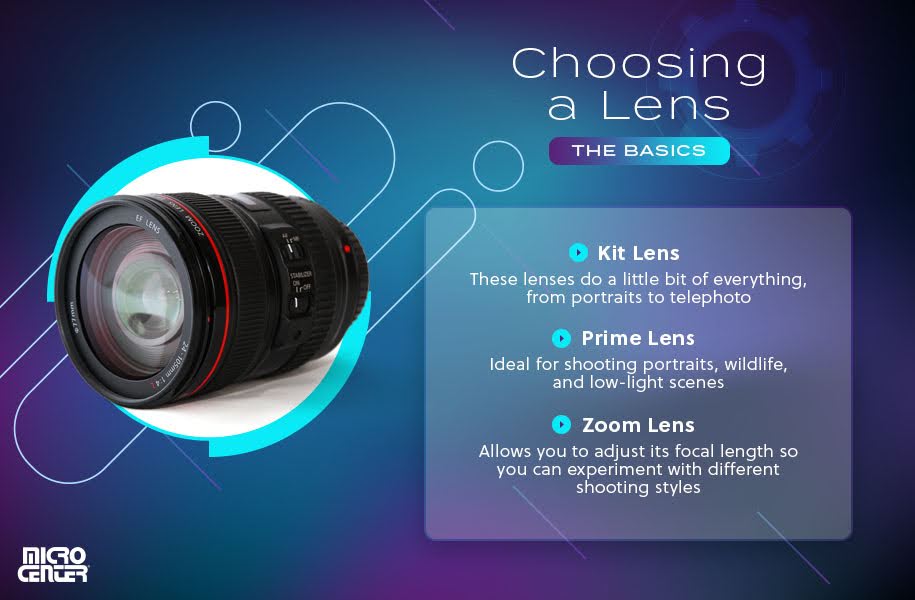
While the topic is a bit more technical than we have space for here, it's a good idea to learn about focal lengths and apertures before choosing a lens. Once you know the fundamentals, you're ready to dive into choosing a lens:
- Kit Lens: These lenses do a little bit of everything, from portraits to telephoto, thanks to their variable apertures and focal lengths. As noted, most starter cameras will come with a kit lens, but most experienced photographers also keep a kit lens on hand to use as a versatile daily driver.
- Prime Lens: If you're ready to expand beyond the kit lens, many pros recommend a prime lens as your first purchase. Prime lenses have a fixed focal length and allow more light to reach the sensor, making them ideal for shooting portraits, wildlife, and low-light scenes. Depending on your frame size, either a "nifty fifty" 50mm or a 35mm prime lens could be right for you.
- Zoom Lens: A zoom lens allows you to adjust its focal length so you can experiment with different shooting styles, often including telephoto and wide-angle photography. "All-in-one" zoom lenses, which often cover focal lengths from 18-200mm or even 18-300mm, are a common choice for beginners. If you’re interested in photographing landscapes or architecture, you might want to go with a wide-angle zoom lens instead.
Accessories for Your Camera
What other tools and accessories will help you shoot your best shots? There are a few of the most important items that every photographer should have on hand.
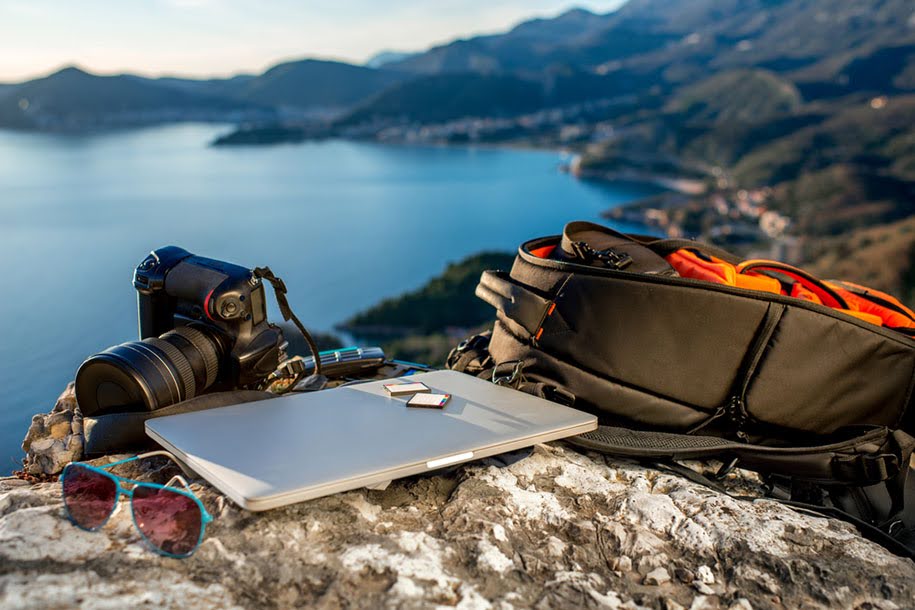
- Memory Card: These handy flash memory cards hold your photos, so it's important to always have one when you need it. Look for a fast write speed — at least a U1 rating is preferable. Memory cards are small and easy to lose, so it's a good idea to grab a memory card case, too.
- Tripod: An affordable tripod is an essential investment if you plan on shooting landscapes, long exposures, streaming video, or anything else that requires extreme stability. Look for a model with a ball head and adjustable legs for easy positioning — and keep an eye on the maximum supported weight to ensure it can hold your camera safely.
- Lights: A "speedlight" or external flash will tremendously expand your lighting options, and many can be used either attached to the camera or away from it. If you want to do high-quality portrait or product photography, you'll probably want to invest in a free-standing LED light panel.
- Camera Bag/Backpack: You probably want to take your new camera out and about — and for that, a padded bag or backpack is a must-have. Choose a model with a padded pocket that fits your camera, plus extra dividers to keep accessories organized.
- Extra Batteries: For mirrorless camera users, it can be smart to pick up an extra camera battery, especially if you plan on doing extended shoots in which you won't have an opportunity to charge your camera.
Whether you're brand new to photography or a seasoned shooter, Micro Center has everything you need to capture the moment. Start with our full selection of cameras, or check out all of our camera accessories to get your full kit together.



